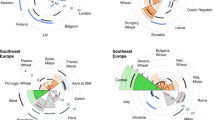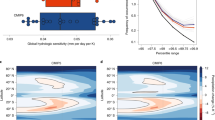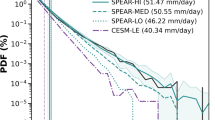Abstract
In the next few decades, it is likely that California must face the challenge of coping with increased impacts from extreme events such as heat waves, wildfires, droughts, and floods. This study presents new projections of changes in the frequency and intensity of extreme events in the future across climate models, emissions scenarios, and downscaling methods, and for each California county. Consistent with other projections, this study finds significant increases in the frequency and magnitude of both high maximum and high minimum temperature extremes in many areas. For example, the frequency of extreme temperatures currently estimated to occur once every 100 years is projected to increase by at least ten-fold in many regions of California, even under a moderate emissions scenario. Under a higher emissions scenario, these temperatures are projected to occur close to annually in most regions. Also, consistent with other projections, analyses of precipitation extremes fail to detect a significant signal of change, with inconsistent behavior when comparing simulations across different GCMs and different downscaling methods.

















Similar content being viewed by others
References
Alexander LV, Zhang X, Peterson TC, Caesar J, Gleason B, Tank AK, Haylock M, Collins D, Trewin B, Rahimzadeh F, Tagipour A, Kumar KR, Revadekar J, Griffiths G, Vincent L, Stephenson DB, Burn J, Aguilar E, Brunet M, Taylor M, New M, Zhai P, Rusticucci M, Vazquez-Aguirre JL (2006) Global observed changes in daily climate extremes of temperature and precipitation. J Geophys Res D-Atm 111:D05109
Cayan D, Tyree M, Dettinger M, Hidalgo H, Das T, Maurer E, Bromirski P, Graham N, Flick R (2008) Climate change scenarios and sea level rise estimates for California 2008 Climate Change Scenarios Assessment. PIER Technical Report CEC-500-2009-014-F
Coles S (2001) An introduction to statistical models of extremes. Springer, New York
Easterling DR, Meehl GA, Parmesan C, Changnon SA, Karl TR, Mearns LO (2000) Climate extremes: observations, modeling, and impacts. Science 289:2068–2074
Frich P, Alexander LV, Della-Marta P, Gleason B, Haylock M, Tank AK, Peterson T (2002) Observed coherent changes in climatic extremes during the second half of the twentieth century. Clim Res 19:193–212
Hallegatte S, Hourcade JC, Dumas P (2007) Why economic dynamics matter in assessing climate change damages: illustration on extreme events. Ecol Econ 62:330–340
Hidalgo H, Dettinger M, Cayan D (2008) Downscaling with constructed analogues: daily precipitation and temperature fields over the United States. PIER Technical Report CEC-500-2007-123
Jagadish SVK, Craufurd PO, Wheeler TR (2007) High temperature stress and spikelet fertility in rice (Oryza sativa L). J Exp Bot. doi:101093/jxb/erm003
Katz RW, Brown BG (1994) Sensitivity of extreme events to climate change: the case of autocorrelated time-series. Environmetrics 5:451–462
Kunkel KE, Pielke RA, Changnon SA (1999) Temporal fluctuations in weather and climate extremes that cause economic and human health impacts: a review. Bull Am Meteorol Soc 80:1077–1098
Mastrandrea MD, Tebaldi C, Snyder CP, Schneider SH (2009) Current and future impacts of extreme events in California. PIER Technical Report CEC-500-2009-026-D
Mastrandrea MD, Heller NE, Root TL, Schneider SH (2010) Bridging the gap: linking climate-impacts research with adaptation planning and management. Clim Chang 100:87–101
Maurer EP, Hidalgo HG (2008) Utility of daily vs. monthly large-scale climate data: an intercomparison of two statistical downscaling methods. Hydrol Earth Syst Sci 12:551–563
Mearns LO, Katz RW, Schneider SH (1984) Changes in the probabilities of extreme high temperature events with changes in global mean temperature. J Clim Appl Meteorol 23:1601–1613
Meehl GA, Karl T, Easterling DR, Changnon S, Pielke R, Changnon D, Evans J, Groisman PY, Knutson TR, Kunkel KE, Mearns LO, Parmesan C, Pulwarty R, Root T, Sylves RT, Whetton P, Zwiers F (2000) An introduction to trends in extreme weather and climate events: observations, socioeconomic impacts, terrestrial ecological impacts, and model projections. Bull Am Meteorol Soc 81:413–416
Meehl GA, Stocker TF, Collins WD, Friedlingstein P, Gaye AT, Gregory J, Kitoh A, Knutti R, Murphy JM, Noda A, Raper SCB, Watterson IG, Weaver AJ, Zhao ZC (2007) Global climate projections. In: Solomon S, Qin D, Manning M, Marquis M, Averyt K, Tignor MMB, Miller HL Jr, Chen Z (eds) Climate Change 2007: the scientific basis, contribution of Working Group I to the Fourth Assessment Report of the IPCC. Cambridge University Press, Cambridge, pp 747–845
Nakicenovic N, Alcamo J, Davis G, de Vries B, Fenhann J, Gaffin S, Gregory K, Grubler A, Jung TY, Kram T et al (2000) Intergovernmental Panel on Climate Change Special report on emissions scenarios. Cambridge University Press, Cambridge
Parry M, Canziani O, Palutikof J, van der Linden P, Hanson C (2007) Climate Change 2007: impacts, adaptation, and vulnerability, contribution of Working Group II to the Fourth Assessment Report of the IPCC. Cambridge University Press, Cambridge
Solomon S, Qin D, Manning M, Marquis M, Averyt K, Tignor MMB, Miller HL Jr, Chen Z (2007) Climate Change 2007: the scientific basis, contribution of Working Group I to the Fourth Assessment Report of the IPCC. Cambridge University Press, Cambridge
Tebaldi C, Hayhoe K, Arblaster JM (2006) Going to the extremes: an intercomparison of model-simulated historical and future changes in extreme events. Clim Chang 79:185–211
Trenberth KE, Jones PD, Ambenje P, Bojariu R, Easterling DR, Tank AK, Parker D, Rahimzadeh F, Renwick JA, Rusticucci M, Soden BJ, Zhai P (2007) Observations: surface and atmospheric climate change. In: Solomon S, Qin D, Manning M, Marquis M, Averyt K, Tignor MMB, Miller HL Jr, Chen Z (eds) Climate Change 2007: the scientific basis, Contribution of Working Group I to the Fourth Assessment Report of the IPCC. Cambridge University Press, Cambridge, pp 747–845
Wood AW, Leung LR, Sridhar V, Lettenmaier DP (2004) Hydrologic implications of dynamical and statistical approaches to downscaling climate model outputs. Clim Chang 62:189–216
Zhang XB, Hegerl G, Zwiers FW, Kenyon J (2005) Avoiding inhomogeneity in percentile-based indices of temperature extremes. J Clim 18:1641–1651
Acknowledgements
We thank Scripps Institute of Oceanography (in particular Mary Tyree) and the Public Interest Energy Research Program for making data and model simulations available for these analyses. We deeply thank John Pfefferle for his invaluable help in preparing this paper, and David Lobell and Gregor Horstmeyer for useful discussions and input. We also thank all the researchers we have consulted for information on their research, which has formed the basis for our summary of current understanding of the impacts of extreme events on California.
Author information
Authors and Affiliations
Corresponding author
Additional information
This paper is adapted from Mastrandrea et al. (2009), PIER Research Report CEC-500-2009-026-D.
Rights and permissions
About this article
Cite this article
Mastrandrea, M.D., Tebaldi, C., Snyder, C.W. et al. Current and future impacts of extreme events in California. Climatic Change 109 (Suppl 1), 43–70 (2011). https://doi.org/10.1007/s10584-011-0311-6
Received:
Accepted:
Published:
Issue Date:
DOI: https://doi.org/10.1007/s10584-011-0311-6




